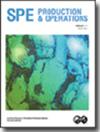利用机器学习完井参数估算多级水力压裂水平井最终采收率的新方法
IF 1.3
4区 工程技术
Q2 ENGINEERING, PETROLEUM
引用次数: 12
摘要
储量估算是任何油藏开发的重要组成部分。预测非常规井的长期生产动态和估计最终采收率(EUR)一直是一个挑战。在油气行业,制定可靠、准确的产量预测是必须的,因为它在决策中起着至关重要的作用。在油气行业中,有几种估算EUR的方法,每种方法都有其优点和局限性。递减曲线分析(DCA)是一种传统的储量估计技术,广泛应用于常规油藏的储量估计。然而,当涉及到非常规油藏时,传统方法在预测低渗透油藏的产量趋势时往往不可靠。近年来,人们开发了许多方法来适应非常规油气藏的高度复杂性,并建立可靠的储量估计。本文提供了一种预测多级水力压裂水平井EUR的方法,该方法优于许多现有方法,结合完井数据,克服了使用DCA或其他传统方法预测产量的一些局限性。将该方法应用于多级水力压裂水平井的EUR预测,并将DCA与人工神经网络(ANN)预测模型相结合,提出了一个由生产历史匹配和预测组成的工作流。开发的工作流程结合了生产历史数据、使用DCA模型的预测和完井数据,以增强EUR预测。预测模型使用人工神经网络技术来预测短期早期生产历史数据(3个月至2年)的EUR。新方法的开发和测试使用了来自四个不同地层的989口多级水力压裂水平井的实际生产和完井数据。开发了16个模型(每个地层4个模型),根据输入参数、结构和生产历史数据周期的不同而不同。在仅给出3个月至2年的生产数据的情况下,开发的模型在预测欧元方面显示出很高的准确性(相关系数为0.85至0.99)。开发的模型使用来自不同DCA模型的产量预测以及完井数据来改进EUR预测。使用完井参数预测EUR以及典型的DCA是本研究提供的主要补充。这项工作的最终成果是一个综合的工作流程,可以通过使用完井数据和早期生产历史数据来预测不同地层的EUR。本文章由计算机程序翻译,如有差异,请以英文原文为准。
A New Approach To Estimating Ultimate Recovery for Multistage Hydraulically Fractured Horizontal Wells by Utilizing Completion Parameters Using Machine Learning
Reserves estimation is an essential part of developing any reservoir. Predicting the long-term production performance and estimated ultimate recovery (EUR) in unconventional wells has always been a challenge. Developing a reliable and accurate production forecast in the oil and gas industry is mandatory because it plays a crucial part in decision-making. Several methods are used to estimate EUR in the oil and gas industry, and each has its advantages and limitations. Decline curve analysis (DCA) is a traditional reserves estimation technique that is widely used to estimate EUR in conventional reservoirs. However, when it comes to unconventional reservoirs, traditional methods are frequently unreliable for predicting production trends for low-permeability plays. In recent years, many approaches have been developed to accommodate the high complexity of unconventional plays and establish reliable estimates of reserves. This paper provides a methodology to predict EUR for multistage hydraulically fractured horizontal wells that outperforms many current methods, incorporates completion data, and overcomes some of the limitations of using DCA or other traditional methods to forecast production. This new approach is introduced to predict EUR for multistage hydraulically fractured horizontal wells and is presented as a workflow consisting of production history matching and forecasting using DCA combined with artificial neural network (ANN) predictive models. The developed workflow combines production history data, forecasting using DCA models and completion data to enhance EUR predictions. The predictive models use ANN techniques to predict EUR given short early production history data (3 months to 2 years). The new approach was developed and tested using actual production and completion data from 989 multistage hydraulically fractured horizontal wells from four different formations. Sixteen models were developed (four models for each formation) varying in terms of input parameters, structure, and the production history data period it requires. The developed models showed high accuracy (correlation coefficients of 0.85 to 0.99) in predicting EUR given only 3 months to 2 years of production data. The developed models use production forecasts from different DCA models along with well completion data to improve EUR predictions. Using completion parameters in predicting EUR along with the typical DCA is a major addition provided by this study. The end product of this work is a comprehensive workflow to predict EUR that can be implemented in different formations by using well completion data along with early production history data.
求助全文
通过发布文献求助,成功后即可免费获取论文全文。
去求助
来源期刊

Spe Production & Operations
工程技术-工程:石油
CiteScore
3.70
自引率
8.30%
发文量
54
审稿时长
3 months
期刊介绍:
SPE Production & Operations includes papers on production operations, artificial lift, downhole equipment, formation damage control, multiphase flow, workovers, stimulation, facility design and operations, water treatment, project management, construction methods and equipment, and related PFC systems and emerging technologies.
 求助内容:
求助内容: 应助结果提醒方式:
应助结果提醒方式:


